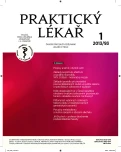How many adolescents are threatened by permanent deterioration of cognitive functions due to marihuana smoking?
Authors:
K. Nešpor 1; L. Csémy 2
Authors‘ workplace:
Oddělení léčby závislostí – mužiPsychiatrická léčebna Bohnice, PrahaŘeditel: MUDr. Martin Hollý
1; Psychiatrické centrum PrahaŘeditel: prof. MUDr. Cyril Höschl, DrSc, FRCPsych
2
Published in:
Prakt. Lék. 2013; 93(1): 21-22
Category:
Of different specialties
Overview
Marijuana abuse in adolescence is associated with the risk of permanent cognitive impairment. Based on two epidemiological studies we estimate the number of such vulnerable adolescents in the Czech Republic to be 23–28 thousand individuals. This risk is higher for boys.
Keywords:
marijuana – cognitive functions – adolescents – deterioration
Sources
1. Barrio G, Jiménez-Mejías E, Pulido J, et al. Association between cannabis use and non-traffic injuries. Accid Anal Prev 2012; 47 : 172–176.
2. de Looze M, van den Eijnden R, Verdurmen J, et al. Parenting practices and adolescent risk behavior: rules on smoking and drinking also predict cannabis use and early sexual debut. Prev Sci 2012 Sep 8 [Epub ahead of print].
3. ESPAD 2011. Evropská školní studie o alkoholu a jiných drogách, Česká republika 2011. Praha: Národní monitorovací středisko pro drogy a drogové závislosti 2012; 12.
4. Harris SK, Csémy L, Sherritt L, et al. Computer-facilitated substance use screening and brief advice for teens in primary care: an international trial. Pediatrics 2012; 129(6): 1072–1782.
5. Hyggen C. Does smoking cannabis affect work commitment? Addiction 2012; 107(7): 1309–1315.
6. Koskinen SM, Ahveninen J, Kujala T, et al. A longitudinal twin study of effects of adolescent alcohol abuse on the neurophysiology of attention and orienting. Alcohol Clin Exp Res 2011; 35(7): 1339–1350.
7. Meiera MH, Caspia A, Amblere A, et al. Persistent cannabis users show neuropsychological decline from childhood to midlife. Proc Natl Acad Sci USA 2012; 109(40): E2657–2664.
8. Nešpor K. Zdravotní rizika kanabis. Revue České lékařské akademie 2012; 8 : 21–23. Dostupné též na: www.medical-academy.cz/cla/revue_8_2012.pdf
9. Nešpor K, Csémy L. „Průchozí“ drogy. Praha: Státní zdravotní ústav v nakladatelství Fortuna 2002; 28 [on-line]. Dostupné na: www.drnespor.eu/gatew6.doc
10. Nešpor K, Csémy L. Marihuana: rizika a krátká intervence. Prakt. Lék. 2012; 92(8): 455–459.
11. Nešpor K, Müllerová M. Jak přestat brát (drogy). 4. rozšířené vydání. Praha: Sportpropag pro Ministerstvo zdravotnictví ČR 2004; 144 [on-line]. Dostupné na: www.drnespor.eu/shd06w2.pdf
12. Rooke SE, Norberg MM, Copeland J. Successful and unsuccessful cannabis quitters: comparing group characteristics and quitting strategies. Subst Abuse Treat Prev Policy 2011; 6 : 30.
13. Zalesky A, Solowij N, Yücel M, et al. Effect of long-term cannabis use on axonal fibre connectivity. Brain 2012; 135(Pt 7): 2245–2255.
Labels
General practitioner for children and adolescents General practitioner for adultsArticle was published in
General Practitioner

2013 Issue 1
Most read in this issue
- Oral manifestations of anaemia
- Metabolic and nutritional disorders associated with alcohol abuse
- The basic rules for providing occupational health services by the law concerning specific health services
- Basics of social cognitive and affective neuroscience XXV. On happiness – the hedonic brain
